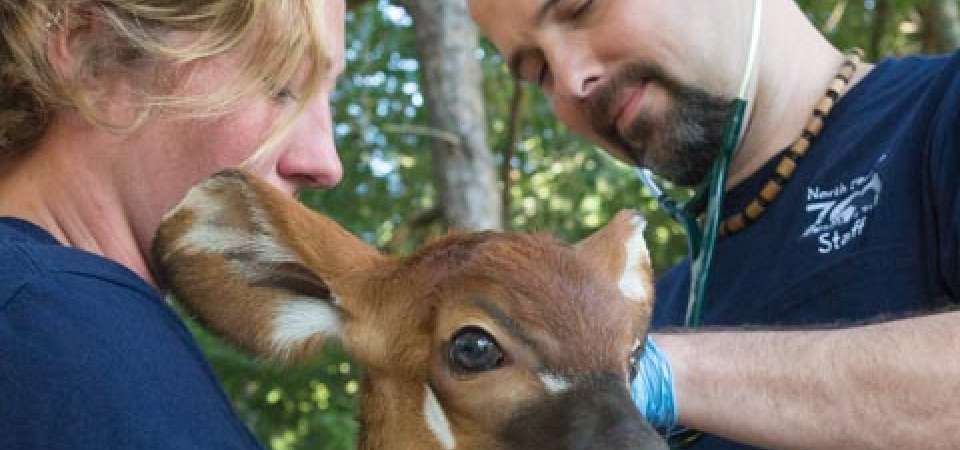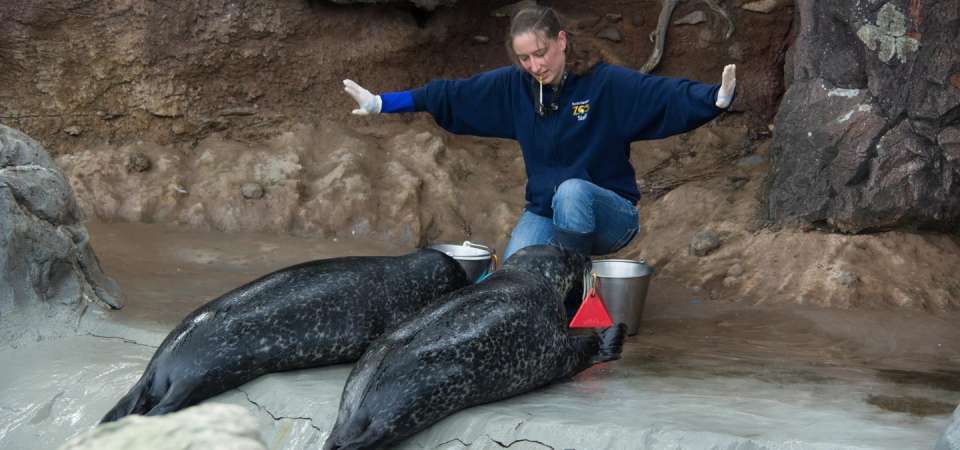

The Zoo anticipates high attendance on sunny weekends. Parking is limited, so arrive early, carpool, and check our site / social pages often for more updates!


Overview:
At the North Carolina Zoo, we are committed to protecting wildlife and other natural resources. Through the Animal Biology and Behavior portion of our Living With Nature Live! events, our goal is to show middle and high school students the many ways that we work with animals at the zoo to preserve their natural habitats and natural habits.
The post-event activities for this event are focused on collaborative practices with groups or classes.
Much like the Zoo aims to collaborate with others across our state and across the globe, we hope that through this event, we can encourage collaboration between students, schools, districts, counties and even countries.Activities offered for classrooms can be used by teachers as they apply to their class. Pre-activities and post-activities are meant to help support and enrich the learning that takes place during the Live Broadcast. All are optional but strongly encouraged in order to align with the standards provided.
Date of Event: May 7, 2019 (Please notice the change in date.)
Designed For: Middle School and High Schools Students (see NC Standard Course of Study alignments below).
Objectives:
The student will be able to identify effects of environmental influences on animal behavior, health, and welfare.
The student will be able to summarize and report on the importance of animal enrichment for animals under human care.
The student will be able to summarize the importance of coexistence and cooperation between humans and animals.
The student will be able to identify potential careers in animal science and welfare.
The student will be able to write informative text using reliable resource information without plagiarizing.
To Register: This event has past, the recording is posted below.
Teacher Information
Our Animal Biology and Behavior portion of our Living with Nature series will be broadcast via Zoom on Wednesday, May 1 at 10 am (rain/weather date is May 7). It will last approximately 1 hour.
In order to set the foundation for the material we will cover when live, we encourage you to use the pre-event activities. This will help prime the learning pump for students. These activities are optional but will allow your students to begin considering the importance of animal biology and behavior as well as how the Zoo provides opportunities for the animals in captivity.
Please note: While there will be plenty of opportunity for interaction with our live event hosts, we ask that you work with your students before and after the event to keep the learning and exploration going!
Read articles - Consider the influences humans have on animals and their natural habitats. Take notes on what surprises you, concerns you, etc.
https://nhpbs.org/natureworks/nwep16b.htm
http://www.anapsid.org/animalshumans.html
Consider ways in which the Zoo might need to step in to support animals due to human error/environmental issues. Make a list of these ideas and suggestions. Include article/source information for future reference.
Guesswork - These are the 4 animals we will discuss. Can you identify what you think the best answer is for each of the following based on your current knowledge of the animal?
Cape porcupine, skunk, cougar, seals or sea lions
Innate behaviors - Behaviors the animals are BORN doing/knowing how to do.
Learned behaviors - Behaviors the animals have been taught or have learned to do over time.
Evolved behaviors - Have any of the animal’s behaviors changed throughout the course of history? Why do you think the change occurred?
Using the booklet template, fill in the information as the Live! event walks you through the Zoo and the awesome animal information you’re going to learn. Remember, if you have questions, ask in the chat portion of the screen! You can draw and write notes. Don’t forget the reflection portion at the end!
Choose an animal. Conduct research to determine the following for the animal. Then, create a presentation to share with the class to teach them about your chosen animal.
For questions or further information email schoolprograms@nczoo.org.
6.L.2 Understand the flow of energy through ecosystems and the responses of populations to the biotic and abiotic factors in their environment.
6.L.2.1 Summarize how energy derived from the sun is used by plants to produce sugars (photosynthesis) and is transferred within food chains and food webs (terrestrial and aquatic) from producers to consumers to decomposers.
CCR Anchor Standard W.2 – Write informative/explanatory texts to examine and convey complex ideas and information clearly and accurately through the effective selection, organization, and analysis of content.
W.6.2 Write to share information supported by details.
a. Introduce a topic and write to convey ideas and information about it including visual, tactual, or multimedia information as appropriate.
b. Provide facts, details, or other information related to the topic
CCR Anchor Standard W.6 (from Proposed Standards –was W.8 in 2010 Standards) –Gather relevant information from multiple print and digital sources, assess the credibility and accuracy of each source, and integrate the information while avoiding plagiarism.
W.6.6 Gather information from multiple print and digital sources that relates to a given topic.
7.L.2 Understand the relationship of the mechanisms of cellular reproduction, patterns of inheritance and external factors to potential variation among offspring.
7.L.2.3 Explain the impact of the environment and lifestyle choices on biological inheritance (to include common genetic diseases) and survival.
CCR Anchor Standard W.2 – Write informative/explanatory texts to examine and convey complex ideas and information clearly and accurately through the effective selection, organization, and analysis of content.
W.7.2 Write to share information supported by details.
a. Introduce a topic and write to convey ideas and information about it including visual, tactual, or multimedia information as appropriate.
b. Provide facts, details, or other information related to the topic.
c. Select domain-specific vocabulary to use in writing about the topic.
CCR Anchor Standard W.6 (from Proposed Standards –was W.8 in 2010 Standards) –Gather relevant information from multiple print and digital sources, assess the credibility and accuracy of each source, and integrate the information while avoiding plagiarism.
W.7.6 Identify quotes providing relevant information about a topic from multiple print or digital sources.
8.L.1 Understand the hazards caused by agents of diseases that effect living organisms.
8.L.1.1 Summarize the basic characteristics of viruses, bacteria, fungi and parasites relating to the spread, treatment and prevention of disease.
8.L.1.2 Explain the difference between epidemic and pandemic as it relates to the spread, treatment and prevention of disease.
8.L.2 Understand how biotechnology is used to affect living organisms.
8.L.2.1Summarize aspects of biotechnology including:
•Specific genetic information available
•Careers
•Economic benefits to North Carolina
•Ethical issues
•Implications for agriculture
8.L.3 Understand how organisms interact with and respond to the biotic and abiotic components of their environment.
8.L.3.1 Explain how factors such as food, water, shelter and space affect populations in an ecosystem.
8.L.3.2 Summarize the relationships among producers, consumers, and decomposers including the positive and negative consequences of such interactions including:
•Coexistence and cooperation
•Competition (predator/prey)
•Parasitism
•Mutualism
8.L.3.3 Explain how the flow of energy within food webs is interconnected with the cycling of matter (including water, nitrogen, carbon dioxide and oxygen).
CCR Anchor Standard W.2 – Write informative/explanatory texts to examine and convey complex ideas and information clearly and accurately through the effective selection, organization, and analysis of content.
W.8.2 Write to share information supported by details.
a. Introduce a topic clearly and write to convey ideas and information about it including visual, tactual, or multimedia information as appropriate.
b. Write one or more facts or details related to the topic.
c. Write complete thoughts as appropriate.
d. Use domain specific vocabulary related to the topic.
e. Provide a closing.
CCR Anchor Standard W.6 (from Proposed Standards –was W.8 in 2010 Standards) –Gather relevant information from multiple print and digital sources, assess the credibility and accuracy of each source, and integrate the information while avoiding plagiarism.
W.8.6 Select quotes providing relevant information about a topic from multiple print or digital sources.
Bio.2.1 Interdependence of Living things and the Environment
Bio.2.1.2 Analyze the survival and reproductive success of organisms in terms of behavioral, structural, and reproductive adaptations.
Bio 2.1.3 Explain various ways organisms interact with each other (including predation, competition, parasitism, mutualism) and with their environments resulting in stability within ecosystems.
Bio.2.1.4 Explain why ecosystems can be relatively stable over hundreds or thousands of years, even though populations may fluctuate (emphasizing availability of food, availability of shelter, number of predators and disease)
Bio.2.2 Human Influence on the Environment
Bio.2.2.1 Infer how human activities (including population growth, pollution,
global warming, burning of fossil fuels, habitat destruction and introduction of
nonnative species) may impact the environment
Bio.3.2 Understand how the environment, and/or the interaction of alleles, influences the expression of genetic traits.
Bio.3.2.3 Explain how the environment can influence the expression of genetic traits.
NCCTE.AN51 - Environmental and Natural Resources I
NCCTE.AN51.01.00 - Investigate organizations related to the environmental and natural resources industry.
NCCTE.AN51.04.00 - Discuss the environmental and natural resources industry and its importance to the national, state, and local economy.
NCCTE.AN51.05.00 - Explore the common career paths in environmental and natural resources.
CCR Anchor Standard W.2 –Write informative/explanatory texts to examine and convey complex ideas and information clearly and accurately through the effective selection, organization, and analysis of content.
W.9-10.2 Write to share information supported by details.
a. Introduce a topic clearly and use a clear organization to write about it including visual, tactual, or multimedia information as appropriate.
b. Develop the topic with facts or details.
c. Use complete, simple sentences as appropriate.
d. Use domain specific vocabulary when writing claims related to a topic of study or text.
e. Providing a closing or concluding statement
W.11-12.2 Write to share information supported by details.
a. Introduce a topic clearly and write an informative or explanatory text that conveys ideas, concepts, and information including visual, tactual, or multimedia information as appropriate.
b. Develop the topic with relevant facts, details, or quotes.
c. Use complete, simple sentences, as well as compound and other complex sentences as appropriate.
d. Use domain specific vocabulary when writing claims related to a topic of study or text.
e. Provide a closing or concluding statement.
CCR Anchor Standard W.6 (from Proposed Standards –was W.8 in 2010 Standards) –Gather relevant information from multiple print and digital sources, assess the credibility and accuracy of each source, and integrate the information while avoiding plagiarism.
W.9-10.6 Write answers to research questions by selecting relevant information from multiple resources.
W.11-12.6 Write answers to research questions by selecting relevant information from multiple resources.